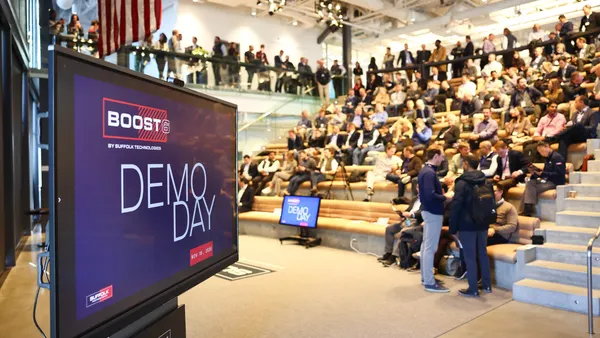Dive Brief:
- Construction robotics startup Asmbld, based in Brooklyn, NY, is working on a robotics system that can reconfigure a room in minutes, and which co-founder Petr Novikov called "like 3-D printing upside down," TechCrunch reported.
-
The "Project Dom Indoors" process involves tiny robots living inside cubes created from 5-inch tiles and aluminum studs that make up the floor of a room.Those cubes can then rise out of the floor to create walls, surfaces and tables, and then slide back into their original position in the floor. The robots have the ability to assemble the cubes into new configurations, transforming a conference room into a lounge or open workspace, for example. Watch a demonstration of the system here.
-
Asmbld said it would cost approximately $12,000 to install the system in a 500-square-foot room, and would involve re-flooring a space to make the floor 5 inches higher than the current floor. Asmbld added that despite the cost, it could save a building owner in the long run, as there would be no additional cost for each room reconfiguration the owner ever decides to implement.
Dive Insight:
The project is still in research stages, and won't be viable for practical use until the plastic tiles can be interchanged with a variety of materials. But developers believe the technology could have significant real-world applications as it becomes more advanced.
"In most large cities, the price of real estate is increasing faster than incomes. It pushes people and businesses into ever smaller spaces. So the question is: how can we fit more space into the same space? Reconfiguration could help accommodate multiple-use scenarios in tiny environments," the company said on its site.
Asmbld's technology could reduce construction and demolition waste, as reconfiguring and redesigning rooms wouldn't need to result in any waste. And replacing construction workers with the tiny robots offers the opportunity for major time and labor costs, the founders said.
"When you’re building a building, there’s coordination, you can’t have the framer, the plumber, the electrician and all of the different contractors working at the same time," said Bruno Araujo, Asmbld’s robotics engineer. "These robots are doing everything at the same time so when you have the structure built, you don’t just have walls, you have electrical conduits, lights, and outlets."
3-D printing and construction robotics technology have yet to create a significant impact on the standard practices and methods of the overall industry currently, but builders are starting to take notice, as they look for new ways to streamline and improve the construction process.













